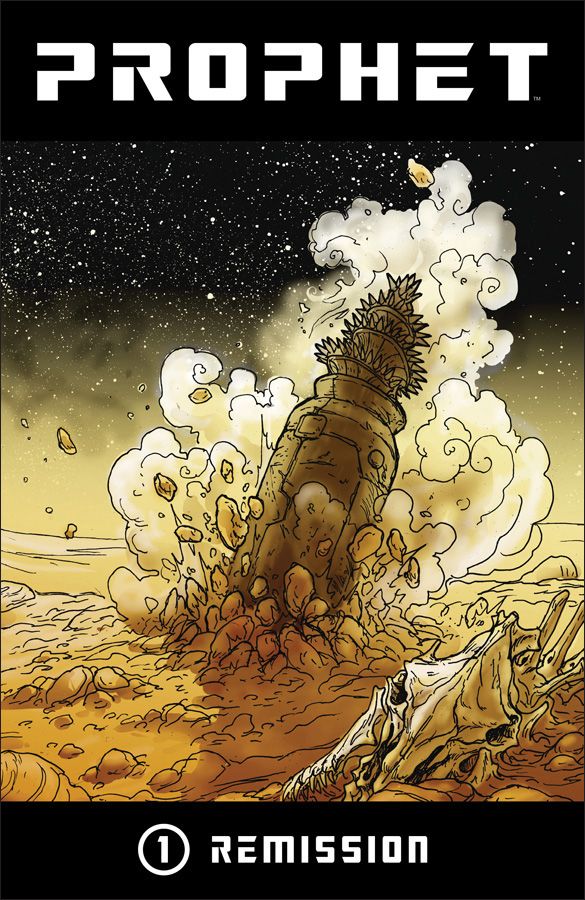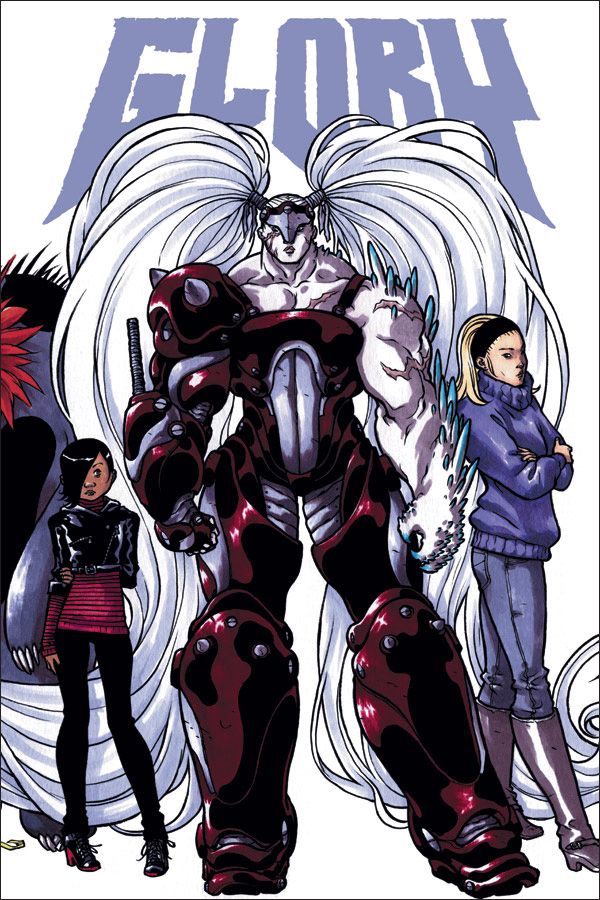This week Image Comics released the first trade paperback for Glory, on the heels of the collection of Prophet, two parts of one of the publisher's more interesting ventures this year: the revival of older, Rob Liefeld-created characters and properties by some of comics' most creative and individual voices, artists whose style couldn't be further from Liefeld's (although, like Liefeld's, are perhaps just as instantly recognizable) .
The Liefeld-by-others aspect was pushed by the publisher as something of a Marvel-esque gimmick with these books (and their companion titles Supreme and Youngblood), numbering the first issues not with #1's, but by picking up the numbering wherever it left off, so that the first issue of the new Prophet, for example, was Prophet #21, and the new Glory began with Glory #23.
In a sign of just how successful the books have been (creatively, if not financially; I 'm only speaking to the former and ignoring the latter in this column), it's worth noting that these trades are titled Prophet Vol. 1: Remission and Glory Vol. 1: The Once and Future Destroyer. That is, now Image is selling them as their own stories with their own beginnings, and have moved past the gimmick.
Both books certainly stand on their own, and Image was wise to let them do so: Both are excellent genre comics, both are more science-fiction and fantasy than superhero and both are very much artists' books — at the risk of diminishing the contributions of Glory writer Joe Keatinge and Prophet writer Brandon Graham (who is also an artist, and drew one of the issues in the first collection and contributed a great deal to the design work), these are comic books that get a great deal of their thrill, their texture and their story through the design and rendering of the artists involved.
It's a very pleasant reversal from Big Two comics, where the majority seem to be writers' books, in which the plot and characters matter more than what fills the panels, exactly, and which artist or artists are drawing them, as evidenced by the increasing interchangeability of artists and colorists, and artists often working at cross-purposes, seemingly fighting for the limelight.
(Another refreshing reversal from business at the Big Two? These comics are cheap; both six-issue, full-color, full-sized trade collections cost $9.99; the individual comics would have cost you about $18 to read serially.)
I read the first issues of each of these when they were released, mostly out of curiosity and affection for some of the creators — Ross Campbell and Brandon Graham are hands-down two of my favorite artists making comics today, and among a handful of cartoonists I'm pretty confident saying will end up being the future of mainstream, pop comics. And then I slipped back into wait-for-the-trade mode on both; as much as I enjoy weekly visits to the comic shop, and reading pamphlets, certain comics are better read in big chunks, and these seemed like those sorts of comics.
As for those big chunks? They certainly fulfilled all the promise those first, serialized issues showed.
Of the two, Prophet is the one that seems hardest to believe began as a Liefeld comic. In fact, it reads more like European science-fiction comics than any superhero or American-made comics, with the only ones it suggests being maybe Marvel and Dark Horse Conan comics, what with its dark-haired warrior wandering and killing his way through a strange, savage world; James Stokoe's Orc Stain, with its organic weaponry and bizarre fantasy architecture; and Graham's own King City, with our hero being aided by an organic tool that provides anything he needs in certain situations, not unlike Joe's cat.
The first few issues focus on this taciturn human's journey to complete a mission, after which point the narrative broadens in a surprising way, taking on a far more epic scale, and revealing our hero is really more of a protagonist, and one of what turns out to be many protagonists.
The pleasure is in the strange details Graham and his artists fill the world with, an entire alien ecology of fantastic conception and imagination, from the individual creatures' designs to the ways they interact with one another.
Simon Roy draws the first three issues, while Farel Dalrymple draws the fourth, Graham himself the fifth and Giannis Milonogiannis the sixth ... plus, there's a short back-up story by Emma Rios. All of them are great artists whose styles differ greatly but have enough overlap that no transition is jarring, and the transitions are accompanied by focus-driven logic. That is, when a new artist is drawing a story, that story is taking place in a new setting, and featuring new characters.
Graham's narrative is shifting, and this volume ends with a climax that seems to turn much of what came before on its head, but with Prophet, it doesn't seem to be where it's going that's as interesting as the route it takes. I've seen things I haven't encountered in any other comics, and if I've seen anything even remotely similar (Matt Howarth's sci-fi comics, Stoke's aforementioned Orc Stain), they didn't look anything like these.
Glory is the more superhero-y of the two, which isn't terribly surprising, given the title character's Wonder Woman-derived inspiration and the fact that Keatinge keeps much of the past Glory stories in continuity. The character is — or was — a superhero, and in flashbacks we see her fighting the Nazis in World War II, arguing with Liefeld's Superman stand-in and, in one sequence, racing through a sort of history of superhero comics (here's a 1950s panel, here's a 1980s panel, etc.).
The way Campbell has designed her, though, she's unlike any superheroine — and few male superheroes — to ever appear on a comic book page. Her physique suggests that of Marvel's Hulk more than any other character, particularly when the story reaches the present (Campbell and Keatinge's Glory changes size and shape, due to her origins as a half-demon, which, when the mood strikes her, can make her slightly amorphous).
The narrative too sort of flips normal expectations: While Glory looks more like a hero than the monstrous villains, she's crazy-violent, and the villains claim to be the good guys, trying to rescue our point-of-view character from Glory's deadly orbit.
The opening chapters are a little rocky, perhaps because they try to fold in previous Glory stories, which aren't terribly necessary — having read none of them, I had no trouble following the pretty simple conflict set-up here — but, like Prophet, the art's the thing.
Campbell has long been one of the best character designers working in superhero comics, his female character not only not looking like clones of one another, but actually looking like real people, the sorts of people you don't often actually see in super-comics. His warrior Glory is a pretty astounding creation, as is all of her bizarre armor and weaponry, but it's her demon enemies and allies that really gives Campbell a chance to shine: At the book's climax, there's an entire invading armada of monster guys, and Campbell designs the hell out of each of them. Few look anything at all like one another, all of 'em look pretty cool.
I think it's also worth mentioning the book is extremely violent and gory; if Glory was inspired by Wonder Woman, she fights more like a berserk Wolverine crossed with, I don't know, a man-eating, blood-crazy shark? She punches and kicks off heads, bites off faces, uses the spine of one foe as a whip against another—all that super-gore you see creeping into Big Two comics, especially those at DC, and especially those at DC written by Geoff Johns?
It pales compared to what you see here, both in the craft with which it's rendered and its level, but unlike, say, Aquaman or Green Lantern, it's actually part of the story here and it's not like Glory is a children's character in cartoons and on lunchboxes, you know? (I guess I remain kind of confused by why so many readers like seeing Green Lantern blow dudes' heads off or Wonder Woman hacking off limbs, when, if they really want lethal, gory superhero stories, Invincible and Glory are right there on the shelves next to the book starring former Superfriends).
The first issues of both Prophet and Glory made me want to read the second issues. And, now that I've read the first volumes of each in trade paperback, I want to read the second volumes of each.
Now if only Image could get artists of this caliber to adapt Rob Liefeld's Twitter account ...



